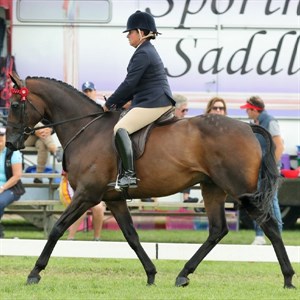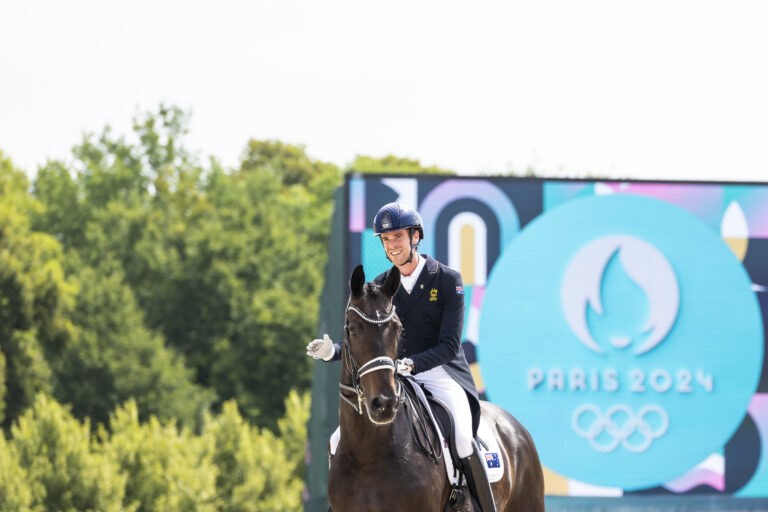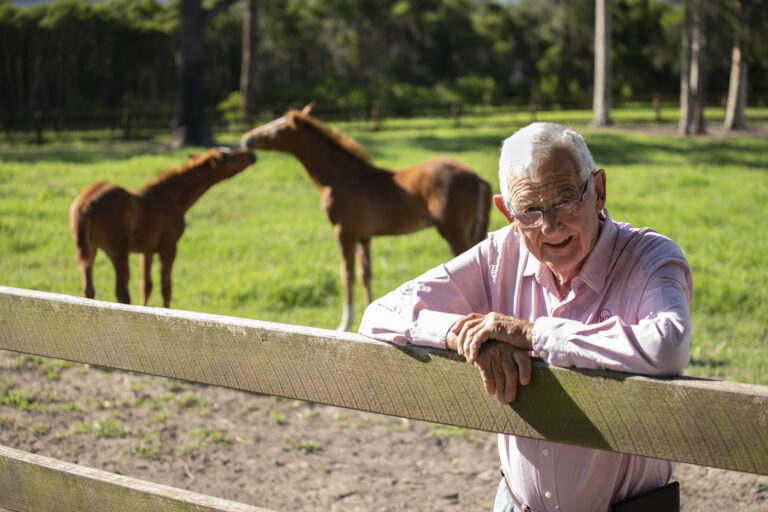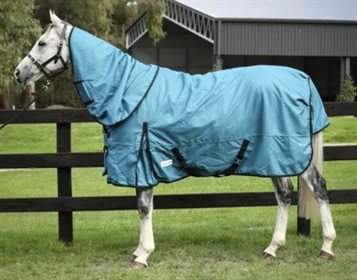Fiona McIntyre and OTT Caravan Rolls On.
Tips for your OTT’s first outing
The time has come! You’ve bitten the bullet and planned your OTT’s first outing; an exciting step forward in your journey together. In this article, Racing Victoria Acknowledged Retrainers Fi McIntyre and Yona and Nina Lloyd share their tips on how to set your horse – and yourself – up for a successful and enjoyable day out.
Whether your first outing is a competition, a clinic, a visit to the local riding club or a trail ride with a friend, these insights and ideas will help ensure both the preparation for your outing, and the big day itself, run as smoothly as possible!
1) Plan your week
Picture yourself heading off to your first outing feeling calm, organised and in control of the situation, then put a plan in place to ensure this vision becomes a reality! Many horse owners live busy lives with competing priorities, however writing out a list of everything you need to get done in the week leading up to your OTT’s first outing, then dividing this into daily tasks, will help ensure you don’t depart for your outing feeling tired, anxious or underprepared. From washing your horse, to cleaning your gear, to sorting out your outfit, to packing the float, there’s plenty to do and not all of it can be achieved in the eleventh hour.
If you’re preparing for a competition and need to plait up, a tip from Nina Lloyd is to consider plaiting the day before. “A lot of off the track thoroughbreds have never been plaited and prepared; if you’re trying to do it all on the one day and they’ve never gone through anything like that it can make the whole experience really, really big. We will often plait their manes the day before, so it’s one less thing for them to go through on the day of the competition.”

Yona Lloyd with OTT British General.
© Felicity Clay
Another useful tip from the Lloyds is to avoid making changes in the week leading up to an outing. Consistency and routine will help you and your horse feel settled, confident and well prepared. “We make sure that the horses aren’t overfed and underworked!” Nina explains. “Often we’ve been feeding them up a bit to put on condition and build muscle, but we don’t increase their intake in the lead up to an outing and we make sure that we’re giving them daily work. That can be challenging for those who aren’t full time riders; however, try to avoid a situation whereby you head off to an outing after giving your horse several days off due to work, school or other commitments. You don’t need to overwork them before an outing, but you also don’t want them to be feeling too fresh or underdone.”
2) Allow plenty of time
“On the day of the outing, allow yourself plenty of time, so you’re not rushing the horse and you’re not rushing yourself,” Fi McIntyre advises.
“Whether we like it or not, sometimes there’s a bit of anxiety there, because it’s the horse’s first outing and we don’t know what he’s going to do. Be self-aware; give yourself extra time to travel and settle in, that will help create a positive experience, not only for the horse, but also for you.”
The Lloyds use the same approach, ensuring they allow enough time between arriving at the venue and riding to either have a pre-ride if it’s a competition, or enough time to do some groundwork. “We always try to do a pre-ride of around 15 or 20 minutes, where they can have a bit of a poke around quietly under saddle without having any pressure put on them. If we can’t do that, we’ll take them out in hand and let them have a look around, then go through the groundwork exercises established in their initial training,” Nina explains. “We do try to take them out with some more experienced horses, horses that are calm in the yards or when tied to the truck. If we’re not taking experienced horses with us, we try to park near friends or clients who have calm horses, as being near them will help create a relaxing environment for the first-timers.”
3) Be safety conscious
Some OTTs and their riders will settle very quickly into new environments, enjoying a calm and unremarkable first outing together without changing much – if anything – from their daily home routine. However it’s not uncommon for a rider to be nervous and for their horse to feel excitable or anxious; if this is the case, take extra precautions.
Having a friend, family member or coach accompanying you on an outing will generally help to settle the nerves, and an extra pair of hands can be very helpful when dealing with an excited horse. Fi McIntyre recommends lunging your horse before you ride, if he is accustomed to this form of exercise, and when the time comes to mount up, consider having a monkey strap attached to the front of the saddle for extra security.
“Sometimes just knowing that a monkey strap or neck strap is there makes all the difference,” Fi explains. “You might not even touch it, but because it’s there you will feel more confident. Particularly at a show where the horse is plaited up, you can’t grab the mane if the horse does something silly.
“Another thing I find – and it doesn’t apply to all OTTs – is that some thoroughbreds can be quite noise sensitive. So one of my tips is to take a set of earplugs if you’re headed somewhere that’s likely to be a bit noisy. Sometimes even the quietest horse can get a fright when all of a sudden the PA system kicks in,” Fi explains. “I do a dress rehearsal at home, trying on the bridle and making sure that it all fits, before I use earplugs at a show. Even an ear bonnet without plugs can be fantastic for blocking out a bit of sound and helping the horse to focus.”
“When you’re riding, try to also be really aware of your environment and what’s happening around you” Fi advises. “Use your peripheral vision, look up not down, and take notice of where other horses or scary objects are, so you can take a wide berth if necessary. Try to have eyes in the back of your head, so you can foresee what might happen, then you can do something to avoid it.”
4) Communicate
“Don’t be afraid to ask questions and ask for help from a more experienced rider or competitor if you need it,” Fi advises. “Even on the day of competition; quite often, myself and other RV Acknowledged Retrainers will have people come up and ask questions. I’m more than happy to help anyone – don’t be afraid to reach out – there’s no such thing as a stupid question!
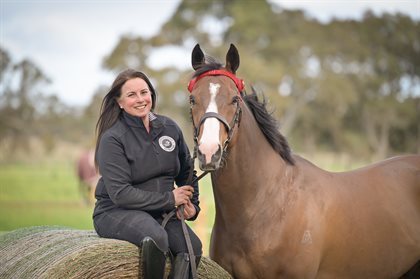
“Don’t be afraid to ask questions and ask for help,” says Fiona McIntyre.
© Racing Photos
“Likewise, communicate with stewards or judges if your horse is at all overwhelmed” Fi continues. “For example, in the showring you may find that your horse doesn’t want to stand still and doesn’t want to stand in a line-up. There’s nothing wrong with that; walk him around, judges and stewards understand how the first show can be, so don’t force your horse to do something that’s going to cause both of you more stress. You could say to other competitors, ‘Sorry, please don’t stand too close, it’s his first show, I don’t know what he’s going to be like.’ There’s nothing wrong with telling the stewards, judge or other competitors around you that it’s your horse’s first show. A lot of people have been in that situation and they will understand.”
5) Enjoy the moment
Congratulations, you’ve done it – you’ve taken your OTT to his first ever outing! This is an achievement in itself. Don’t despair or be discouraged if not every aspect of the day went to plan, try to focus on the best moments and learn from any parts that were less than ideal.
“If the day didn’t go well, that doesn’t mean it never will,” Nina Lloyd explains. “Some OTTs go out once or twice, and they realise it’s not racing, and they’re totally cool. Whereas others need to go out 25 times before they work that out! You can’t always tell which type the horse is going to be based on how they’ve behaved or progressed at home; they can be fantastic at home and then become super reactive when they’re out. You learn by doing.”
It’s a sentiment Fi McIntyre echoes. “Every horse is an individual, and sometimes you’ve got to make mistakes. Sometimes you’ll find you haven’t given him enough work, or you’ve worked him too much. You have to be prepared for the fact that it’s not always going to be perfect. At the end of the day, there’s trial and error involved and there’s always something you can take away from each outing and learn from, particularly that very first outing.
“Above all else, you want it to be a really enjoyable day, you want to be able to sit back and enjoy the fact that you’ve gotten this horse out to its very first event. And anything on top of that is a bonus, but don’t put yourself under pressure if you didn’t get a ribbon, it’s not a disaster. If you pick up a ribbon, that’s fantastic, that’s a bonus! However the real pleasure, the real reward is actually getting them out there. And one last thing – when you do get to a competition, or take your OTT on an adventure somewhere – send the horse’s previous owner, breeder, trainer, or anyone else who has cared for him in the past and shared his stories with you – a photo. They love to see their horses out and about enjoying life after racing!”
This article was written in conjunction with Racing Victoria. To find out more about their OTT Community, click here.
READ THE LATEST NEWS ARTICLES HERE

